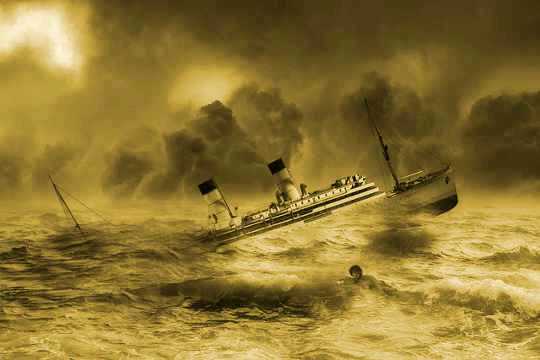
Image by Willgard Krause
We all like to think we are prepared for the unexpected. Yet in my work as an executive coach, I’ve listened to many people describe professional situations where they were caught off guard and discovered that their reactions under pressure surprised them.
Whether it’s a thought leader who gets tongue-tied at a critical moment or a manager who loses his or her temper during a staff meeting, many people are bewildered by their own conduct when the stakes are high.
These eye-opening gaps between how people hope they will respond and how they actually react are symptomatic of a breakdown in trust. This may start as a breakdown in trust between organizations and their employees, but it can gradually evolve into a breakdown in trust within individuals themselves.
Circumstances such as these leave many hardworking people feeling emotionally paralyzed, tempted to make impulsive decisions, and striving to please external authority figures at precisely the moment they should be listening to their authentic inner voice.
Thriving In Changing Times
What do you do when unexpected problems arise that threaten to overwhelm you, undermine your ability to trust others, or even compromise your ability to align your personal and professional values? Whether you are trying to figure out what you genuinely want to do professionally, what kind of culture will compliment your strengths, or even how to be a better parent and partner — this process can help. It will improve how you see yourself, clarify your expectations of others, and help you foster a sense of trust that’s vital to making sound decisions at critical turning points in your life and career.
To thrive in changing times, you will have to reinvent yourself more than once in the course of your career. In fact, job change happens more frequently today than perhaps in any previous generation. And every time you change jobs, your professional agility will be tested, along with your emotional resilience and even physical stamina. The pragmatic demands of the workplace challenge all of us to succeed in ways that reflect our authentic selves.
The story of the Titanic contains vital lessons for anyone who feels stuck in a dead-end job or a professional role that stunts their potential and damages their self-esteem. This is because, when the Titanic sank, everything that had defined these passengers sank with it — and they were left with nothing but their innate capacity to relate to themselves and others if they wanted to survive.
The Titanic Story: From Big Ship to Lifeboat
The Titanic was considered unsinkable, and so it came as something of a shock when the ship unexpectedly struck an iceberg and became fatally damaged. The crew was unprepared to abandon ship, and there weren’t enough lifeboats for everyone aboard.
For those Titanic passengers and crew who made it into one of the lifeboats, there were new challenges. They suddenly found themselves in tiny vessels adrift in the treacherous, freezing waters of the Atlantic Ocean. In the span of a few hours, those who were still alive went from enjoying themselves aboard the largest, most extravagant luxury liner in history to facing imminent death if they didn’t overcome their terror and pull together as a group.
Perhaps the most famous and well-known story concerns Lifeboat #6 and how these brave men and women managed to face their deepest fears, overcome a leadership challenge, trust one another when their lives were on the line, and take effective group action until help arrived. For today’s readers, I believe many of the most relevant lessons from this part of the Titanic story involve how some of the individuals on this lifeboat overcame their personal fears and united as a group to beat the odds.
At first, many passengers refused to accept that the Titanic was sinking, and in the lifeboats, some people became overwhelmed by their emotions and unable to do anything. Some couldn’t adapt to the situation and the upending of expected roles and norms. They remained stuck in what I call the “Big Ship mindset.”
What makes this story so valuable today is that, on that fateful night, the survivors in that tiny vessel needed to make a fundamental mental shift if the group was going to survive. In essence… adopt what I refer to as the “Lifeboat mindset.” This involves letting go of unquestioned assumptions, acknowledging danger, facing our fears, putting aside our assigned or expected roles, trusting ourselves and others, and working as a group to help save everyone.
The Titanic is a powerful metaphor for people today struggling to put the unexpected changes they face into perspective. For instance, in many cases, when unexpected problems threaten a company or a department, the people involved report experiencing a breakdown of norms and trust. In some organizations there is so little trust that people feel terribly isolated, disconnected from colleagues and friends, and distanced from their authentic selves. Unable to make sense of this isolation, some people make adjustments to keep themselves sane. Often, these adjustments involve striving to act like everything is just fine on the outside.
However, a complex range of emotions often simmers on the inside, and if people avoid exploring and managing these emotions, the more likely they are to make a difficult situation worse by reacting ineffectively or unpredictably under stress. In a worst-case scenario, if a situation undermines someone’s trust in themselves, this affects all parts of their lives, including their family and personal relationships.
Using denial to stay sane in an insane situation is understandable, if misguided. Out of a natural desire to protect themselves, people often stop being emotionally honest, which damages their connection with their own truth.
Like the captain and crew on the Titanic who refused to heed warnings of icebergs until it was too late, people in today’s workforce can hide from and deny their own warning signs: cutting themselves off from their feelings, refusing to acknowledge problems, and avoiding taking meaningful risks on their own behalf. Often in the name of job security, people can choose to believe what leaders and others tell them is safe rather than trusting their own judgment.
People who cultivate the Lifeboat mindset learn to expect the unexpected. They remain aware of potential danger and attempt to take action before it strikes. If they can avoid a problem, why wouldn’t they? When they can’t — and they get caught up in a tumult of change — they ready the lifeboats and prepare to survive, whatever that means specifically in their situation.
The truth is, at some point everyone will be surprised by unexpected problems. We will be caught unprepared. When this happens, will we panic and deny the problem, then flounder and make things worse? Or will we recognize this situation, pause to handle our emotions and assess what’s happening, then take action to foster the group effort that helps rescue everyone.
What is the Lifeboat Process?
At its most basic, the Lifeboat Process is a shift in mindset, from the “Big Ship mindset” to the “Lifeboat mindset.” This shift in thinking can be made anytime. It can be helpful in every aspect of our lives. But it is essential in a crisis when we must act effectively with others under pressure. Metaphorically, when we hit an iceberg in our lives, we must shift our thinking from minding our own business on the “big ship” to working strategically with others to survive in a “lifeboat.”
This “Lifeboat shift” in thinking changes how we relate in three ways. First, it involves how we relate to ourselves and how we navigate our own emotions and inner challenges. When things go wrong, fear, anxiety, panic, anger, and many other difficult and unwanted emotions can emerge — which I call our “inner iceberg.”
Being able to act effectively in a crisis depends first on coping with this emotional and mental challenge inside ourselves; otherwise, we risk acting in self-defeating ways. If we have been conditioned by the Big Ship mindset to play our role, to do what others tell us, to not cause trouble, and to suppress our true feelings, this makes it even more important to restore our connection to our authentic selves.
The second area is interpersonal awareness and how we interact with others under pressure. Once the Titanic slipped beneath the ocean, the power structure or hierarchy of command was less important than interpersonal influence. Rank didn’t matter. Personal authority won out over sanctioned authority, and informal leadership was respected over official titles.
Informal leadership means trusting oneself, supporting others to overcome their fear and trust themselves, and promoting an attitude of joint effort to solve common problems, no matter what your expertise. To do this, we have to be aware of others and pay attention to all aspects of verbal and nonverbal communication.
The third area involves working with the group itself, which means leveraging the group’s diverse strengths and pulling together. In a lifeboat situation, people competing with one another to call the shots can leave everyone dead in the water. Collaboration becomes a survival skill.
What this means in real life depends on the circumstances, but the actions we take make a difference. The passengers on Lifeboat #6 had few resources, but they used what they had to stay warm, stay afloat, and stay determined to live long enough to be rescued. The stories of how they survived through trusting one another and using their resources effectively provide timeless inspiration for us all.
The Eight Questions That Make Up The Lifeboat Process
Here is a brief overview of the eight questions that make up the Lifeboat Process, which proceeds step-by-step to help you operate authentically when the stakes are high:
- Is this ship safe? Generations of people have been fascinated with the simple question: If the Titanic had been better prepared, could this tragedy have been prevented? Probably. Is your company prepared? The first step in the Lifeboat Process is assessing the environment where you work. Does it align with your values? Does it embody the Big Ship mindset? If it’s an option, should you leave now or perhaps not board at all?
- What do I do if I sense trouble? The Titanic ignored warnings about icebergs. Even as Titanic launched, there were issues that led some crew members and passengers to sense trouble. But no one felt authorized to speak up or take action. However, by pausing and assessing when you notice red flags, you can recognize problems both on the horizon and in your emotional reactions to danger.
- When is it time to get in a lifeboat? People sometimes deny problems or delay their reactions to them, hoping to fix them before they are noticed. Both happened on the Titanic, and this made the inevitable evacuation worse. Making the “Lifeboat shift” in our mindset is critical to addressing problems proactively.
- What if I freeze in a crisis? The Big Ship mindset conditions us to ignore, minimize, or suppress our feelings. This can create an “inner iceberg” of difficult emotions that erupt in a crisis, causing us to freeze when we need to act. When people aren’t aligned with their authentic selves and personal values, they can break down under pressure. Once a crisis arrives, the first goal is to recognize, acknowledge, and manage our own emotional response.
- How do I find inner strength under pressure? When the unexpected strikes, the solution isn’t in the employee handbook. Business as usual doesn’t work, and the old norms don’t apply. Thus, we need to cultivate the emotional agility and personal judgment to respond authentically and strategically under pressure. We empower ourselves with the personal authority to become problem solvers in a crisis.
- Who can I trust in a crisis? The first person we need to trust is ourselves, by summoning the courage necessary to admit our vulnerabilities and limits. This allows us to assess what we need to solve a problem and evaluate who within a group will help. This also cultivates the discernment necessary to clarify who to trust and why to trust them under pressure. We learn to ignore titles and status and seek to align with people who also embody the Lifeboat mindset.
- How do we survive together? The answer to this question is simple: by adopting the attitude that we must all look out for one another. We need everyone’s help to pull through, and this means everyone needs to be supported and included. We treat everyone equally and don’t dismiss anyone as “expendable.”
- What will be my story? The Titanic survivors had no idea how long they’d be stuck at sea, and neither do we in our lives. We just have to keep rowing, having faith that taking the next right action in the present moment will ultimately bring success. This approach doesn’t just help us survive — it ensures that we thrive. We write our stories of survival and success continually, through our ongoing actions, by adopting the Lifeboat mindset throughout our lives, rather than waiting for a crisis in order to change.
Ultimately, when it comes to our authentic leadership potential, the Lifeboat Process teaches us that, when the emotions of a group shift from fear to trust, the collective mindset shifts from self-help to us-help.
What distinguishes people who respond effectively under pressure from those who stay stuck? It isn’t just related to how people think, although being thoughtful is important. It isn’t just about how people feel, although cultivating the patience to identify and accept feelings is central.
It is about navigating the inner challenges that arise when a crisis hits, tapping into our deeper strengths under pressure, and working with others to solve problems in ways that align with our values and authentic selves. This is foundational to charting your own course in the workplace and in your life.
©2020 by Maggie Craddock. All Rights Reserved.
Reprinted with permission of the publisher,
New World Library. www.newworldlibrary.com
Article Source
Lifeboat: Navigating Unexpected Career Change and Disruption
by Maggie Craddock
 Today’s hardworking professionals are navigating sudden waves of financial stress, management shakeups, and downsizing. Using the experiences of Titanic survivors as a powerful metaphor, executive coach Maggie Craddock offers lessons for a transformative approach to our professional lives, one that recognizes that “every man for himself” doesn’t work long-term. Lifeboat is organized as a series of key questions we all need to ask ourselves when facing unexpected career disruption or difficult changes. These questions help readers clarify their authentic priorities, assess the group energy that guides a particular workplace, and identify the type of job that will help them reach their true potential.
Today’s hardworking professionals are navigating sudden waves of financial stress, management shakeups, and downsizing. Using the experiences of Titanic survivors as a powerful metaphor, executive coach Maggie Craddock offers lessons for a transformative approach to our professional lives, one that recognizes that “every man for himself” doesn’t work long-term. Lifeboat is organized as a series of key questions we all need to ask ourselves when facing unexpected career disruption or difficult changes. These questions help readers clarify their authentic priorities, assess the group energy that guides a particular workplace, and identify the type of job that will help them reach their true potential.
For more info, or to order this book, click here. (Also available as a Kindle edition and as an Audiobook.)
About the Author
 Maggie Craddock, author of Lifeboat, is a veteran executive coach known for her work with Fortune 500 CEOs and senior management. She has been featured on CNBC, ABC News, and National Public Radio. She is also a certified therapist and also the author of The Authentic Career and Power Genes. More information at WorkplaceRelationships.com.
Maggie Craddock, author of Lifeboat, is a veteran executive coach known for her work with Fortune 500 CEOs and senior management. She has been featured on CNBC, ABC News, and National Public Radio. She is also a certified therapist and also the author of The Authentic Career and Power Genes. More information at WorkplaceRelationships.com.


























